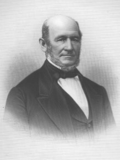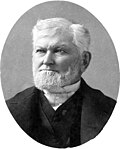Members
The following individuals were members of the Anointed Quorum (spouses are listed together and plural marriage relationships are indicated):
| Name | Notes | |
|---|---|---|
| James Adams | Lawyer and close friend of Joseph Smith. | |
| Harriet Denton Adams | Wife of James Adams | |
 | Almon W. Babbitt | First secretary and treasurer of the Territory of Utah, and a member of the Council of Fifty. |
 | Louisa Beaman | Plural wife of Joseph Smith |
 | John Milton Bernhisel | The original delegate of the Utah Territory in the United States House of Representatives (1851–1859, 1861–1863) and a member of the Council of Fifty. |
 | Reynolds Cahoon | Member of the Presiding Bishopric and one of the inaugural members of the Council of Fifty. |
 | Thirza Stiles Cahoon | Wife of Reynolds Cahoon |
 | William Clayton | Member and Clerk of the Council of Fifty. |
 | Margaret Moon Clayton | Wife of William Clayton |
 | Alpheus Cutler | Member of the Council of Fifty. After the succession crisis, he became the 1st President of The Church of Jesus Christ (Cutlerite). |
 | Lois Lathrop Culter | Wife of Alpheus Cutler |
 | Elizabeth Davis Durfee | Plural wife of Joseph Smith |
| Harriet Page Wheeler Decker | ||
 | Joseph Fielding | Member of the Council of Fifty, brother of Mary Fielding, the second wife of Hyrum Smith, and an uncle of Joseph F. Smith, the sixth president of the church. |
 | Hannah Greenwood Fielding | Wife of Joseph Fielding |
| Olive Grey Frost | Plural wife of Joseph Smith | |
| John P. Greene | Member of the Council of Fifty and the chief of police in Nauvoo, Illinois in 1844. Greene supervised the destruction of the press of the Nauvoo Expositor which set in motion a chain of events that eventually led to the death of Joseph Smith. | |
| Charles Hyde | ||
 | Orson Hyde | A member and President of the Quorum of the Twelve Apostles, and a member of the Council of Fifty. |
 | Marinda Nancy Johnson Hyde | Wife of Orson Hyde and a plural wife of Joseph Smith |
 | Zina Dianatha Huntington Jacobs | 3rd General President of the Relief Society. Zina was a plural wife of Joseph Smith and later Brigham Young |
 | Heber C. Kimball | Member of the Quorum of the Twelve Apostles, First Counselor in the First Presidency, and a member of the Council of Fifty. |
| Vilate Murray Kimball | Wife of Heber C. Kimball | |
 | Helen Mar Kimball | Plural wife of Joseph Smith |
| Joseph C. Kingsbury | ||
 | Sarah Ann Whitney Kingsbury | Wife of Joseph C. Kingsbury and a plural wife of Joseph Smith and later Heber C. Kimball |
 | Mary Elizabeth Rollins Lightner | Plural wife of Joseph Smith |
 | William Law | Second Counselor in the First Presidency to Joseph Smith. After his excommunication for apostasy, Law published the Nauvoo Expositor, the destruction of which set in motion a chain of events that eventually led to the death of Joseph Smith. |
| Jane Silverthorne Law | Wife of William Law | |
| Cornelius P. Lott | A member of the Council of Fifty and a Danite leader. [1] | |
| Permelia Darrow Lott | Wife of Cornelius P. Lott | |
 | Amasa Lyman | Member of the Quorum of the Twelve Apostles, counselor in the First Presidency, and a member of the Council of Fifty. |
| Mary L. Tanner Lyman | Wife of Amasa M. Lyman | |
 | William Marks | First counselor in the First Presidency of the Reorganized Church of Jesus Christ of Latter Day Saints and a member of the Council of Fifty. |
| Rosannah Robinson Marks | Wife of William Marks | |
| George Miller | Second Bishop of the Church and member of the Council of Fifty. | |
| Mary Catherine Fry Miller | Wife of George Miller | |
| Ruth Moon | Plural wife of William Clayton | |
 | Isaac Morley | First Counselor to the Bishop of the Church and member of the Council of Fifty. |
| Lucy Gunn Morley | Wife of Isaac Morley | |
| Fanny Young Murray | ||
| Joseph B. Noble | ||
| Mary A. Beaman Noble | Wife of Joseph B. Noble. | |
| John E. Page | Member of the Quorum of the Twelve Apostles, and a member of the Council of Fifty. | |
| Mary Judd Page | Wife of John E. Page | |
 | Orson Pratt | An original member of the Quorum of Twelve Apostles, member of the Council of Fifty and Official church historian. |
 | Parley P. Pratt | An original member of the Quorum of Twelve Apostles, member of the Council of Fifty. |
 | Mary A. F. Pratt | Wife of Parley P. Pratt and a plural wife of Joseph Smith |
 | W. W. Phelps | A church printer, editor, and songwriter, scribe to Joseph Smith, and a member of the Council of Fifty. |
| Sally Waterman Phelps | Wife of W. W. Phelps | |
 | Levi Richards | Served as a physician for Joseph Smith and a member of the Council of Fifty. |
 | Willard Richards | Second Counselor in the First Presidency, member of the Quorum of the Twelve Apostles, Official church historian, and a member of the Council of Fifty. |
| Jennetta Richards Richards | Wife of Willard Richards | |
 | Sidney Rigdon | Counselor in the First Presidency of Church of Jesus Christ of Latter Day Saints and a member of the Council of Fifty. After the Succession Crisis he became President of the Church of Jesus Christ of the Children of Zion. |
 | Lucy Decker Seely | Plural wife of Brigham Young |
 | Sylvia P. Sessions | Plural wife of Joseph Smith |
 | Agnes Coolbrith Smith | Plural wife of Joseph Smith |
 | George A. Smith | First Counselor in the First Presidency, member of the Quorum of the Twelve Apostles, Official church historian, and a member of the Council of Fifty. |
 | Bathsheba W. Smith | 4th General President of the Relief Society and wife of George A. Smith. |
 | Hyrum Smith | Brother of Joseph Smith, Assistant President of the Church, Presiding Patriarch, Apostle, Counselor in the First Presidency, and a member of the Council of Fifty. |
 | Mary Fielding Smith | Wife of Hyrum Smith |
 | John Smith | Uncle of Joseph Smith, 4th Presiding Patriarch, Assistant Counselor in the First Presidency, and a member of the Council of Fifty. |
| Clarissa Lyman Smith | Wife of John Smith | |
 | Lucy Mack Smith | Mother of Joseph Smith and author of Biographical Sketches of Joseph Smith, the Prophet, and His Progenitors for Many Generations. |
 | Joseph Smith | Founder of the Latter Day Saint movement. |
 | Emma Hale Smith | Wife of Joseph Smith and 1st President of the Female Relief Society of Nauvoo. |
 | Samuel H. Smith | One of the younger brothers of Joseph Smith, and one of the Eight Witnesses. |
 | William Smith | One of the younger brothers of Joseph Smith, member of the Quorum of the Twelve Apostles, 3rd Presiding Patriarch (LDS Church), and a member of the Council of Fifty. After the Succession Crisis he became Petitioner for Patriarchate (RLDS Church). |
 | Eliza R. Snow | 2nd General President of the Relief Society. Plural wife of Joseph Smith and Brigham Young |
 | Orson Spencer | Member of the Council of Fifty and 1st President of the University of Utah |
| Catherine Curtis Spencer | Wife of Orson Spencer | |
 | John Taylor | 3rd President of The Church of Jesus Christ of Latter-day Saints |
| Leonora Cannon Taylor | Wife of John Taylor | |
| Mercy Fielding Thompson | ||
 | Newel K. Whitney | First Bishop of the Church and a member of the Council of Fifty. |
 | Elizabeth Ann Smith Whitney | Wife of Newel K. Whitney. |
 | Lyman Wight | Member of the Quorum of the Twelve and a member of the Council of Fifty. After the Succession Crisis he became President of the Church of Christ(Wightite) [2] |
 | Wilford Woodruff | 4th President of The Church of Jesus Christ of Latter-day Saints |
 | Phoebe Carter Woodruff | First wife of Wilford Woodruff. |
| Lucien Woodworth | ||
| Phebe Watrous Woodworth | Wife of Lucien Woodworth | |
 | Brigham Young | 2nd President of The Church of Jesus Christ of Latter-day Saints |
 | Mary Ann Angell Young | Wife of Brigham Young |
 | Joseph Young | Brother of Brigham Young, one of the First Seven Presidents of the First Quorum of the Seventy, and a member of the Council of Fifty. |
| Jane A. Bicknell Young | Wife of Joseph Young |